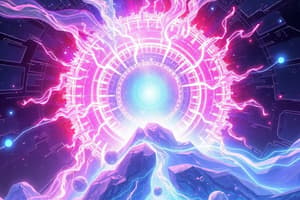Podcast
Questions and Answers
What are the two factors involved in kinetic energy?
What are the two factors involved in kinetic energy?
- Velocity and height
- Mass and velocity (correct)
- Gravity and height
- Mass and acceleration
What type of energy is possessed by objects due to their position?
What type of energy is possessed by objects due to their position?
- Thermal energy
- Kinetic energy
- Mechanical energy
- Potential energy (correct)
In elastic collisions, what is conserved?
In elastic collisions, what is conserved?
- Heat energy
- Kinetic energy (correct)
- Potential energy
- Momentum
What is the primary factor that determines the inertia of an object?
What is the primary factor that determines the inertia of an object?
What happens to kinetic energy in inelastic collisions?
What happens to kinetic energy in inelastic collisions?
What happens to the momentum of an object when its mass or velocity increases?
What happens to the momentum of an object when its mass or velocity increases?
In the equation 𝐾𝐸 = 𝑚𝑣2/2, what is the relationship between kinetic energy and velocity?
In the equation 𝐾𝐸 = 𝑚𝑣2/2, what is the relationship between kinetic energy and velocity?
What is the term for the product of the force applied and the duration of time it was applied?
What is the term for the product of the force applied and the duration of time it was applied?
What type of potential energy is due to an object's position in a gravitational field?
What type of potential energy is due to an object's position in a gravitational field?
Why is it more difficult to stop a heavier object than a lighter one?
Why is it more difficult to stop a heavier object than a lighter one?
What is the momentum of an object at rest?
What is the momentum of an object at rest?
What is the result of increasing the force applied or the time of contact on an object?
What is the result of increasing the force applied or the time of contact on an object?
What is the fundamental principle behind the law of conservation of momentum?
What is the fundamental principle behind the law of conservation of momentum?
What is the key characteristic of an elastic collision?
What is the key characteristic of an elastic collision?
What is the difference between kinetic energy and potential energy?
What is the difference between kinetic energy and potential energy?
What is the primary reason why the total momentum of a system before and after collision are equal?
What is the primary reason why the total momentum of a system before and after collision are equal?
What is the main characteristic of an inelastic collision?
What is the main characteristic of an inelastic collision?
What is the definition of energy in terms of work?
What is the definition of energy in terms of work?
Flashcards are hidden until you start studying
Study Notes
Energy
- Kinetic energy: energy of bodies in motion
- Directly proportional to object's mass and square of its velocity (KE = mv²/2)
- Potential energy: energy possessed by objects due to their position
- Gravitational Potential Energy (GPE) = mgh, where m is mass, g is acceleration due to gravity, and h is height
Collisions
- Elastic collisions: objects separate after collision, kinetic energy conserved
- Examples: billiard balls, ping-pong balls, hard objects
- Inelastic collisions: objects separate after collision, kinetic energy not conserved
- Energy converted to sound, heat, and deformation of objects
Momentum
- Inertia: ability of body to resist outside force, increases with mass
- Momentum: mass in motion, depends on mass and velocity
- Momentum = mass x velocity
- Objects at rest have inertia but no momentum
- Increase in mass or velocity increases momentum
Momentum and Force
- Impulse: force applied multiplied by duration of time
- Greater impulse results in greater change in momentum
- Force and time are important to consider when changing momentum
Law of Conservation of Momentum
- States that total momentum of a system remains constant in the absence of external forces
- Mathematically expressed as: momentum before = momentum after (m1v1 + m2v2 = m1v1 + m2v2)
Energy Types
- Mechanical energy: energy of a particle due to its motion and position
- Consists of kinetic energy and potential energy
- Other forms of energy: light, sound, chemical, heat
Studying That Suits You
Use AI to generate personalized quizzes and flashcards to suit your learning preferences.




